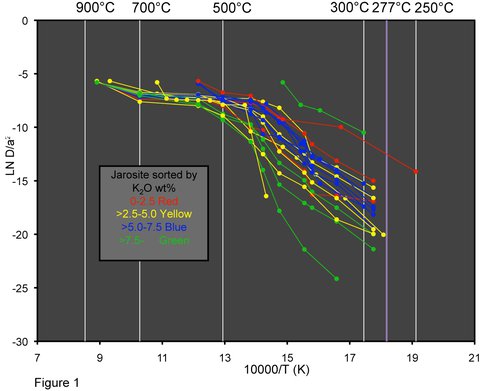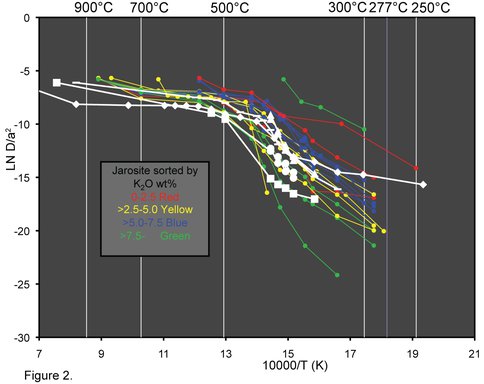2010 Annual Science Report
 Rensselaer Polytechnic Institute
Reporting | SEP 2009 – AUG 2010
Rensselaer Polytechnic Institute
Reporting | SEP 2009 – AUG 2010
Project 5: Vistas of Early Mars: In Preparation for Sample Return
Project Summary
To understand the history of life in the solar system requires knowledge of how hydrous minerals form on planetary surfaces, and the role these minerals play in the development of potential life forms. One hydrous mineral found on Earth and inferred from in situ measurements on Mars, is the mineral Jarosite, KFe3(SO4)2(OH)6. We are investigating whether radiometric ages, specifically 40Ar/39Ar ages on jarosite can be interpreted to accurately record climate change events on Mars. This project not only requires understanding the conditions required for jarosite formation and preservation on planetary surfaces, but also assessing under what conditions its “radiometric clock” can be reset (e.g., during changes in environmental conditions such as temperature). By studying jarosites formed by a variety of processes on Earth, we will be prepared to analyze and properly interpret ages measured from jarosite obtained from future Mars sample return missions.
Project Progress
Ar diffusion experiments on jarosite
Using 40Ar/39Ar data mined from Lueth et al., (2004), a jarosite Arrhenius diagram was constructed based on the stepwise release of 39Ar (Figure 1). Unirradiated aliquots of Smithsonian jarosite sample C7137 were prepared and out gassed via step heating to test if the 40Ar release pattern is consistent with the 39Ar release patterns from the Lueth et al. (2004). Figure 2 shows a comparison of the Arrhenius data, in which there is, in general, good agreement with published results. Based on a jarosite thermal stability study by Xu et al. (2009), all temperatures used in the step-heating analyses represented in Figures 1 and 2 are above the maximum temperatures where jarosite remains stable. Therefore, these data violate a requirement for experimentally determining diffusion kinetics from an Arrhenius diagram (i.e., the mineral must remain stable during the diffusion experiment). To determine the capability of our current laboratory setup to perform diffusion experiments at low temperature conditions, a series of step-heat analyses using unirradiated aliquots were performed at temperatures consistent with jarosite stability (<300°C). The heating durations for these analyses were 4 hours. The resulting incremental gas released indicates measurable sample volumes can indeed be retrieved at these relatively low furnace temperatures. Based on these successful tests of low-temperature heating, samples of varying size fractions of C7137 jarosite have been prepared for irradiation where a homogeneous distribution of 39Ar will be produced throughout the crystals and the diffusion kinetics can be properly evaluated. The limitation in using the 40Ar signal to construct an Arrhenius diagram is that the initial distribution of the isotope in question should be homogeneous, (i.e. no diffusive loss has occurred between sample formation and analysis) however it is presently unknown if jarosite sample C7137 has experienced 40Ar loss over geologic time. This will be assessed once step heat experiments are performed on irradiated jarosite.
Bighorn Basin of Wyoming: an analog site to the Burns Formation at Meridiani Planum on Mars
The Paleocene-to-Eocene sedimentary succession preserved in the Bighorn Basin of Wyoming was targeted as a possible analog site to the Burns Formation at Meridiani Planum on Mars. Specifically, the paleosols preserved in the Fort Union and Willwood Formations (Kraus, 1998; Kraus and Hasiotis, 2006) have properties consistent with those determined for the Martian Burns Formation (Grotzinger et al., 2005). At both localities, sediments were at some point completely submerged beneath the water table and subsequently exhumed and desiccated. Sediments at both locations contain jarosite and hematite/goethite throughout the vertical succession, where jarosite growth is attributed to post-depositional oxidation/acidification as the water table migrated downward through the stratigraphic section during final drainage of the basin. Figure 3 depicts schematically the relative position of the water table and the depositional surface for the Meridiani Planum and Bighorn Basin sedimentary sections.
Although the initial conditions and depositional settings may have varied, the post-depositional history for both locations includes residence beneath the water table (saturated zone) followed by a relative lowering of the water table through the sedimentary strata. A vertical transect of jarosite samples has been collected (Figure 4) and prepared for 40Ar/39Ar analysis to test the feasibility of dating the timing of drainage within the Fort Union/Willwood Formations of the Bighorn Basin.
The same sampling strategy can potentially be implemented for future Mars sample return missions to determine when water existed at or near the surface at jarosite localities. Determining when water was present in the near surface environment has implications for identifying localities where favorable conditions persisted for the development of life on the Martian surface.
References
Grotzinger, J.P., Arvidson, R.E., Bell III, J.F., et al., 2005, Stratigraphy and sedimentology of a dry to wet eolian depositional system, Burns formation, Meridiani Planum, Mars: Earth and Planetary Science Letters, v. 240, p. 11-72.
Lueth, V.W., Rye, R.O., and Peters, L., 2005, “Sour gas” hydrothermal jarosite: ancient to modern acid-sulfate mineralization in the southern Rio Grande Rift: Chemical Geology, v. 215, p. 339-360.
Lueth, V.W., Rye, R.O., Peters, L., 2004, 40Ar/39Ar data repository for “Sour Gas” hydrothermal jarosite: Ancient to modern acid-sulfate mineralization in the southern Rio Grande Rift: New Mexico Bureau of Geology and Mineral Resources, Argon Open-file Report, OF-AR 22, p. 1-41.
Kraus, M.J., 1998, Development of potential acid sulfate paleosols in Paleocene floodplains, Bighorn Basin, Wyoming, USA: Paleogeography, Palaeoclimatology, Palaeoecology, v. 144, p. 203-224.
Kraus, M.J., Hasiotis, S.T., 2006, Significance of different modes of rhizolith preservation to interpreting paleoenvironmental and paleohydrologic settings: examples from Paleogene paleosols, Bighorn Basin, Wyoming, USA: Journal of Sedimentary Research, v. 76, p. 633-646.
Xu, H., Zhao, Y., Vogel, S.C., Hickmott, D.D., Daemen, L.L., Hartl, M.A., 2009, Thermal expansion and decomposition of jarosite: a high-temperature meutron diffraction study: Physics and Chemistry of Minerals, DOI 10.1007/s00269-009-0311-5.
Figure 1. Arrhenius diagram constructed using the 39Ar release from the 40Ar/39Ar stepheat data of Lueth et al. (2004). Purple line at 277°C is the maximum temperature at which jarosite stability was maintained in the study of Xu et al. (2009), which constrains the breakdown of jarosite to hematite and yavapaiite as between 277 and 300°C. Note that most steps plot to the left (higher temperature) of this field.
Figure 2. Comparison of 40Ar release data from step-heating unirradiated C7137 jarosite with the 39Ar-based data of Lueth et al. (2004) presented in Figure 1.
Figure 3. Schematic representation of the hydrodynamic similarities between the Burns Formation on Mars and the Fort Union/Willwood Formations on Earth. Black horizontal line marks the surface for Mars and the predepositional surface/top of formation for Earth. Blue lines mark the location of the water table. For Mars: T1-time of deposition of basal eolian sand, T2- time of deposition of sheet sands, T3- time of deposition of subaqueous interdune sediments, T4- time following retreat of hydrosphere (today). For Earth: T1- predepositional condition, T2- time of deposition of units, T3- postdepositional burial beneath water table, T4- time following exhumation/drainage of the section (today). Note both sedimentary packages were below the water table (T3) following final deposition and were subsequently drained when the water table passed downward through the section (T4)- a condition consistent with the environment at both localities today. FU- Fort Union, Ww- Willwood.
Figure 4. Magnetostratigraphic correlations for the Fort Union and Willwood Formations of the Bighorn Basin (from Kraus, 1998). Sample codes corresponding to the vertical profile of jarosite samples collected are depicted on the right. If the jarosite indeed records oxidation due to drainage of the section, a “younging-downward” age progression is expected.
-
PROJECT INVESTIGATORS:
-
PROJECT MEMBERS:
John Delano
Co-Investigator
Bruce Watson
Co-Investigator
Joseph Kula
Postdoc
David Gombosi
Graduate Student
-
RELATED OBJECTIVES:
Objective 1.1
Formation and evolution of habitable planets.
Objective 2.1
Mars exploration.
Objective 7.1
Biosignatures to be sought in Solar System materials



